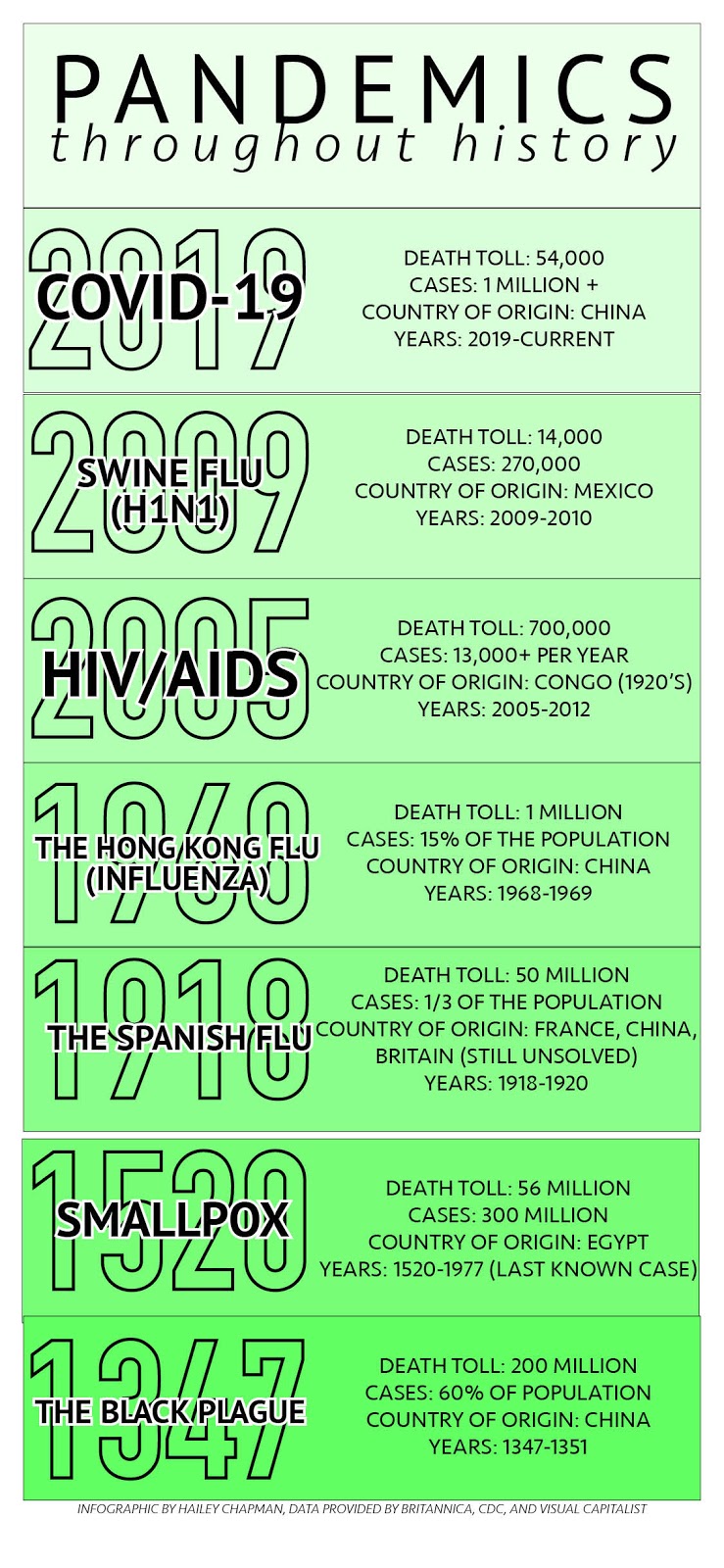BY HAILEY CHAPMAN
Amidst the national pandemic that is COVID-19, it is important we look back as a nation to previous pandemics that shook the world as we know it.
Currently, the coronavirus has reached more than 1 million cases, with the death toll reaching 54,000, according to information by Johns Hopkins University.
The virus’s spread began in Wuhan, China, and made its way to North America in January. As of today, it is not a matter of curing the disease, but rather damage control. Testing kits have been distributed throughout the world, and a 30-day stay-at-home order has been issued in almost every state.
In 2009, the world was swept off its feet by the Swine Flu, or H1N1. The death toll was the lowest of all pandemics, but was prevalent to this generation as it was likely one of the first we have lived through. The strain was found to have originated in Mexico, and the pandemic lasted for less than a year. Scientists were able to quickly find a vaccine that led to such a low mortality rate.
The AIDS/HIV pandemic peaked in 2005 and lasted for seven years before it was able to be contained. While it became prevalent in 2005, the origin of AIDS/HIV began in 1920 in the Congo. Each year, more than 13,000 deaths occurred, with 700,000 total deaths. The disease is most commonly spread through sexual activity, injection drug use and carriers passing it on to their offspring.
Originating in China during the 1960s, the Hong Kong Flu infected 15% of the population, resulting in 50 million deaths. The disease was so infectious it quickly spread across the nation within 17 days. Most prevalent, soldiers traveling from Vietnam into California were said to have caused the outbreak in America. The pandemic came in two waves, with the second causing a much larger mortality rate.
One third of the population was affected by the Spanish Flu; scientists were unable to pinpoint its origin, but narrowed it down to Britain, France or China. During the course of this two-year pandemic, 50 million people died. While the strain was named after Spain, it was not due to its origin, but rather its historical significance. During World War II, Spain was a neutral territory, which meant they were able to warn and alert others of the pandemic. Countries at war neglected to report on the outbreak as to not alert their enemies of dwindling populations, which could be seen as a sign of weakness and allow them to plan more strategic attacks.
The 1500s were devastated by the Smallpox outbreak, originating in Egypt. Approximately 56 million people died as a result of the disease, with 300 million cases across the nation. The disease was considered an endemic due to its high mortality rates and the eradication of it was a huge medical success. The last known case of smallpox was in 1977, showing its long lasting impact on the world.
Perhaps the most notorious pandemic across the nation was the Black Plague of 1347. Otherwise known as “the Black Death,” 60% of the population became infected while 200 million people perished from the illness. The disease was spread via the bite of infected rat fleas or black rats. One of the largest causes of the viral spread was the cramped and dirty living conditions at the time. While dying of the disease was known to be slow and painful, even those without illness would suffer from severe starvation and dehydration as a result of the filthy living conditions. The disease originated in China, but spread most prevalently throughout Europe.
While it is uncertain what the future looks like amid a national pandemic, the best thing we can do as a nation is stay informed, sanitize often and socially distance ourselves.
All facts and figures courtesy of Britannica, CDC, and VisualCapitalist.

